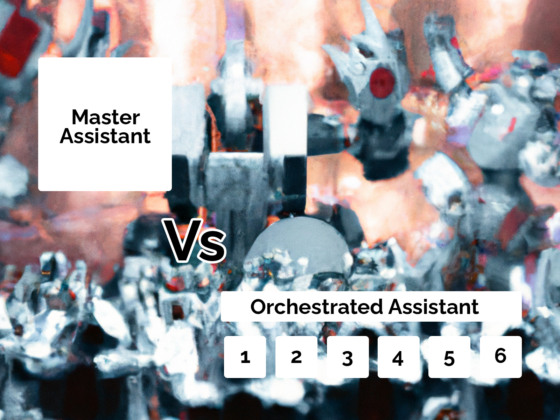We have best practices when implementing Conversational AI – find the repetitive tasks you do every day that don’t require analytical thought to solve, and then see if they can be solved with an automated system. We know it works.
That’s great. We have a starting point!
But what’s after that? If you tackle the low-hanging fruit to get started, then what can you do next?
From there you need to consider a holistic use of AI.
That’s what Alain Mowad, Director, Product Marketing at Talkdesk told us in a recent interview with VUX World.
Great customer experience
Consider what happens when you experience excellent customer service.
Let’s say someone’s doing DIY, upgrading their lighting. They hit a snag – some of the lights don’t work. They think they must have bought faulty lights, so they call the manufacturer’s contact centre to complain.
What if the contact centre’s AI assistant quickly ascertains that the issue isn’t with the lights themselves (because they have data that many customers call up about faulty lights when they’re rewiring their house), and that the issue is more likely to be in the way they’ve been installed.
And then, during the call, the customer is texted a link to show them the best way to install those lights so that they work. Even better, imagine the AI assistant stays on the line to assist with any additional troubleshooting during the installation process.
Then, two days later, they receive another text from the company, checking-in to see if their lights are still working as expected.
If you were that customer, would you buy that brand again knowing that you’ll be taken care of if you have issues? Would you recommend it to a friend?
AI and Service Design
For the customer, it feels seamless, but in the background, the AI assistant is pulling data from a whole manner of different systems, surfacing knowledge, using multiple channels and modalities and tracking the installation process. The AI is the service.
This is all possible today, but to get to this level of AI maturity, you need to stop thinking about conversational AI as a point solution. Something that solves one problem. Instead, consider your whole customer journey from end to end, and how AI can help streamline customer experience throughout the whole service pipeline.
What we’re talking about is something that’s much closer to service design, where you’re considering the big picture, and working to improve the entire customer journey.
Beyond conversations
Conversational AI is fantastic at getting to the heart of the problem quickly. As Alain says, “The quicker you determine a customer’s intent when they’re contacting you, the quicker you’re able to solve their problem.”
Some customer problems are likely best served with conversational AI, too. However, some needs may be better met in other ways.
For example, if we’re thinking about the entire service for the customer who’s installing new lights, then perhaps NLU can be utilised to define their intent when they call, but the best way to service their need may not be a conversation. The solution should be the best thing to help a user given the context of the conversation.
For example, perhaps they’re using a desktop computer. Chances are they’re not installing the lights right at this moment. Therefore, you might send them to the correct part of the website for them to do some research. Or maybe they’re on mobile and the number they’re calling from (associated to their CRM record) paid for fast track shipping. Chances are, this customer has an urgent job to do, so let’s not waste any more of their time: send them a link to a brief YouTube tutorial.
As Alain says, it’s all about customer effort. “Anything you can do to reduce customer effort and make it easier for them to get their enquiry resolved is going to result in a better customer experience.”
Holistic AI in organisations
Here, we’re heading to the holistic use of AI services, where the AI is the brain that sits behind the service across all channels and determines the best way to meet the needs of each customer, depending on their use case and context.
You see, if you’re not implementing AI in a holistic way, and you’re not connecting it to all parts of your organisation, then you’re not going to get the full benefit of it.
In fact, you might well fail. That’s because AI is only as good as the value it brings users. The value you can bring is dictated by the products you offer, the services you provide, the processes that underpin those products and services, and the technology that enables those processes.
Therefore, for your AI service to reach its full potential, it has to have coverage across everything your organisation does, and across all of the channels your business supports.
Consider one element of your business infrastructure; your knowledge base, for example. It needs to be up to date, it needs to be a single source of truth, and it all needs to be connected in such a way that it can be accessed by everyone who needs to access it (including the AI assistant).
“If you don’t update your knowledge base, then employees are treating everything like it’s a new problem” says Alain.
Something’s missing
Frequently, discussions about AI focus on systems, efficiencies and data, but one vital component is left out. So, what do we need to mention?
Humans.
None of this works without humans in the loop. While AI can make predictions with a vast store of data, humans can reason and assume when they only have a relatively small amount of messy data. That’s because we’ve got life experience to give context to data and we’re excellent pattern-matchers.
Both human and machine can help each other to find a better outcome.
Talkdesk has a product called Quality Management where AI rapidly skims through all call transcripts (far faster than a human ever could) and scores them for quality and to identify agent coaching opportunities. Using business rules, it determines which calls meet the criteria to be flagged for review by a supervisor or quality analyst.
That’s when the human enters the loop. They analyse the calls and the scores to identify areas for improvement in the customer experience as well as agent coaching opportunities, and then decide on the next best steps.
So you see, if every call transcript was read by a team of humans, the process would be practically impossible given the volume of calls, and not to mention prohibitively expensive. AI can solve that. It looks for patterns in huge datasets.
The thing AI can’t do well is something humans excel at – to analyse any outliers and make conclusions about them.
Holistic use of AI means that humans are in the loop everywhere! The best scenario is when you have a feedback loop where your staff are constantly improving the effectiveness of AI.
Not enough humans
There is one issue with humans though – there’s a massive lack of AI experts.
On the plus side, we now have no-code/low-code tools that allow anyone to work with AI. For example, Talkdesk has AI Trainer which allows call centre agents and supervisors to continuously train the AI models that helps their work by tackling repetitive calls, so they can focus on the harder ones.
These tools allow entire organisations to design AI to their own needs without hiring AI experts. In other words, “it allows them to focus on their business, their business objectives and business outcomes versus the actual technology driving them.”
That’s great because the people who understand the problem can create the solution themselves. Imagine if everyone in your organisation was doing that together? That’s an example of Holistic AI.
Thanks to Alain Mowad for providing these insights and to Talkdesk for sponsoring this article.
If you want to know more, you really must read Talkdesk’s ‘The ultimate AI playbook for contact centres’.




